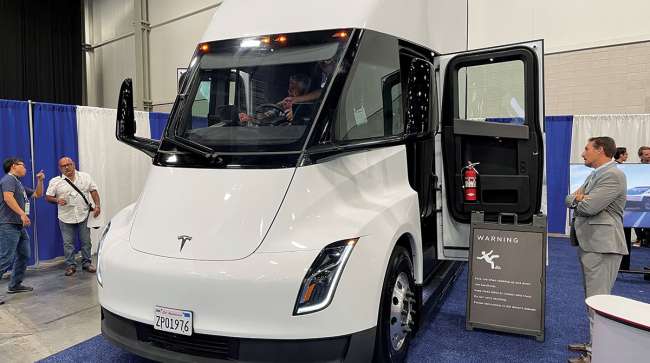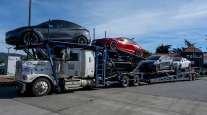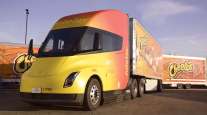Staff Reporter
Tesla Semi Crash, Fire Mark NTSB’s First EV Truck Case

[Stay on top of transportation news: Get TTNews in your inbox.]
In its first accident investigation of an electric-battery heavy truck, the National Transportation Safety Board is examining the Aug. 19 crash of a 2024 Tesla Semi that burned to the ground after it veered off Interstate 80 and slammed into a tree in the Sierra Nevada mountains.
The crash and resulting fire are being investigated by NTSB, the Federal Motor Carrier Safety Administration, California Highway Patrol and Tesla Inc.
The single-vehicle crash occurred at 3:13 a.m. as a Tesla driver, who sustained no reported injuries, was traveling east on I-80 from Livermore, Calif., to Tesla Giga Nevada in Sparks, Nev. Tesla’s facility where the electric truck was heading is located about an hour from Lake Tahoe, which spans California and Nevada. The facility bills itself as “one of the world’s highest-volume plants for electric motors, energy storage products, vehicle powertrains and batteries — producing billions of cells per year.”
The electric Semi crash happened near Emigrant Gap in Placer County, a high-elevation ridge on the historic California Trail west of Donner Pass.
That location on I-80 has two concrete lanes in each direction divided by a forested center median and paved shoulders. The maximum posted speed limit there is 55 mph for commercial trucks and 65 mph for passenger vehicles.
NTSB spokesperson Sarah Taylor Sulick told Transport Topics, “The investigation is ongoing and focusing on the emergency response to the event. This is the first investigation involving an electric truck-tractor.”
She noted that NTSB investigations can take one to two years to be completed. When NTSB announced in mid-September that it had opened an investigation into the Tesla electric tractor-trailer crash and fire, it stated, “All aspects of the crash remain under investigation while the NTSB determines the probable cause, with the intent of issuing safety recommendations to prevent similar events.”
An FMCSA spokesperson stated the agency had no information to provide since NTSB is the primary investigative federal government organization looking into the incident.
According to NTSB, “The truck-tractor departed the roadway to the right while navigating a right-hand curve and uphill grade. The vehicle struck a traffic delineator permanently mounted on a steel post, collided with a tree about 12.5 inches in diameter and continued down an earthen slope to rest against several trees.”
Then the truck’s lithium-ion electric battery system ignited in a post-crash fire. NTSB stated that Tesla sent a technical expert to the scene to help with “assessing high-voltage hazards and fire safety.”
Tesla’s media relations didn’t respond to a Dec. 16 email from Transport Topics requesting comment about the incident and the current status of the battery-powered electric heavy truck development.
Emergency responders tried to control the blaze by dumping 50,000 gallons of water to extinguish the flames and cool the truck’s batteries.
Did You Know?
50,000 gallons of water is estimated to fill a steel tank that is 25 feet in diameter and 14.23 feet high and weighs 4,735 pounds.
Firefighters worked to prevent the fire from spreading to the surrounding forest. CAL FIRE deployed an airplane to the immediate area and doused it with fire retardant to keep the flames from causing more damage.
A thermal scanner was deployed to monitor the temperatures of the burning batteries. Both directions of I-80 were closed for about 15 hours until firefighters determined the batteries were at a safe temperature for operations to begin for recovering the truck.
The Tesla electric Semi was then moved to an undisclosed open-air facility and monitored for 24 hours. During the observation period, officials detected no reignition of the truck-tractor’s battery system.
In a separate incident involving a Tesla vehicle, one person died and seven others were injured on New Year’s Day when a Tesla Cybertruck that was reported to be carrying fireworks and fuel exploded and caught fire outside President-elect Donald Trump’s Las Vegas hotel, authorities said.
Las Vegas Metropolitan Police and Clark County Fire Department officials said the person who died was inside the futuristic-looking pickup truck. Seven people nearby had minor injuries, and several were treated at a nearby hospital.
The fire in the valet area of the Trump International Hotel Las Vegas was reported at 8:40 a.m., a county spokesperson said in a statement. According to a law enforcement official speaking on condition of anonymity, the truck was procured via a vehicle rental app.
Want more news? Listen to today's daily briefing below or go here for more info:




